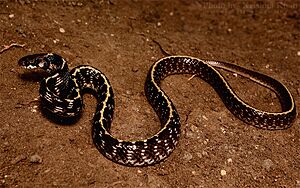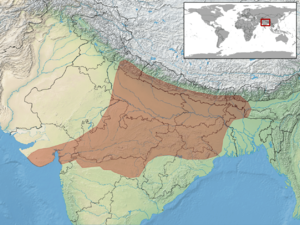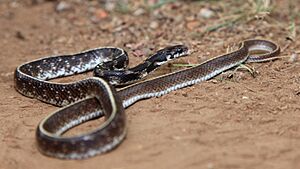Indian egg-eating snake facts for kids
Quick facts for kids Indian egg-eating snake |
|
|---|---|
 |
|
| Indian egg-eater at Amravati | |
| Conservation status | |
| Scientific classification | |
| Genus: |
Elachistodon
|
| Species: |
westermanni
|
 |
|
| Synonyms | |
|
|
The Indian egg-eating snake or Indian egg-eater (Elachistodon westermanni) is a rare species of egg-eating snake in the family Colubridae. The species is endemic to the Indian subcontinent. It is also called Westermann's snake, reflecting its scientific name. The snake belongs to the monotypic genus Elachistodon.
Etymology
The specific name, westermanni, is in honor of Dutch zoologist Geraldus Frederick Westermann (1807–1890).
Geographic range
The Indian egg-eating snake is found in Bangladesh, India, and Nepal. Recent discoveries of the species come from Maharashtra, Gujarat, Punjab, Madhya Pradesh, Telangana and Karnataka.
Habitat
The preferred natural habitats of E. westermanni are forest and shrubland, at altitudes of 40–1,000 m (130–3,280 ft).
Description
E. westermanni is glossy brown to black, with bluish white flecks posteriorly and a middorsal creamy stripe from neck to tail tip. The head is brown with a black arrow mark. The ventrals are white with brown dots. Adults may attain a total length of 78 cm (31 inches), with a tail 11 cm (4+1⁄4 inches) long.
Behaviour
The Indian egg-eating snake is a diurnal or nocturnal, terrestrial species that shows remarkable dexterity in scaling vegetation. When provoked, it raises the anterior portion of the body, forming S-shaped coils as a defensive strategy.
Diet
E. westermanni exclusively feeds on bird eggs that lack embryonic growth. It has special adaptations such as vertebral hypapophyses, projections of the cervical vertebrae, that jut into the oesophagus, are enamel-capped, and help in cracking eggs. The only other snakes that share these egg-eating adaptations are in the genus Dasypeltis found in Africa.
Reproduction
E. westermanni is oviparous.



